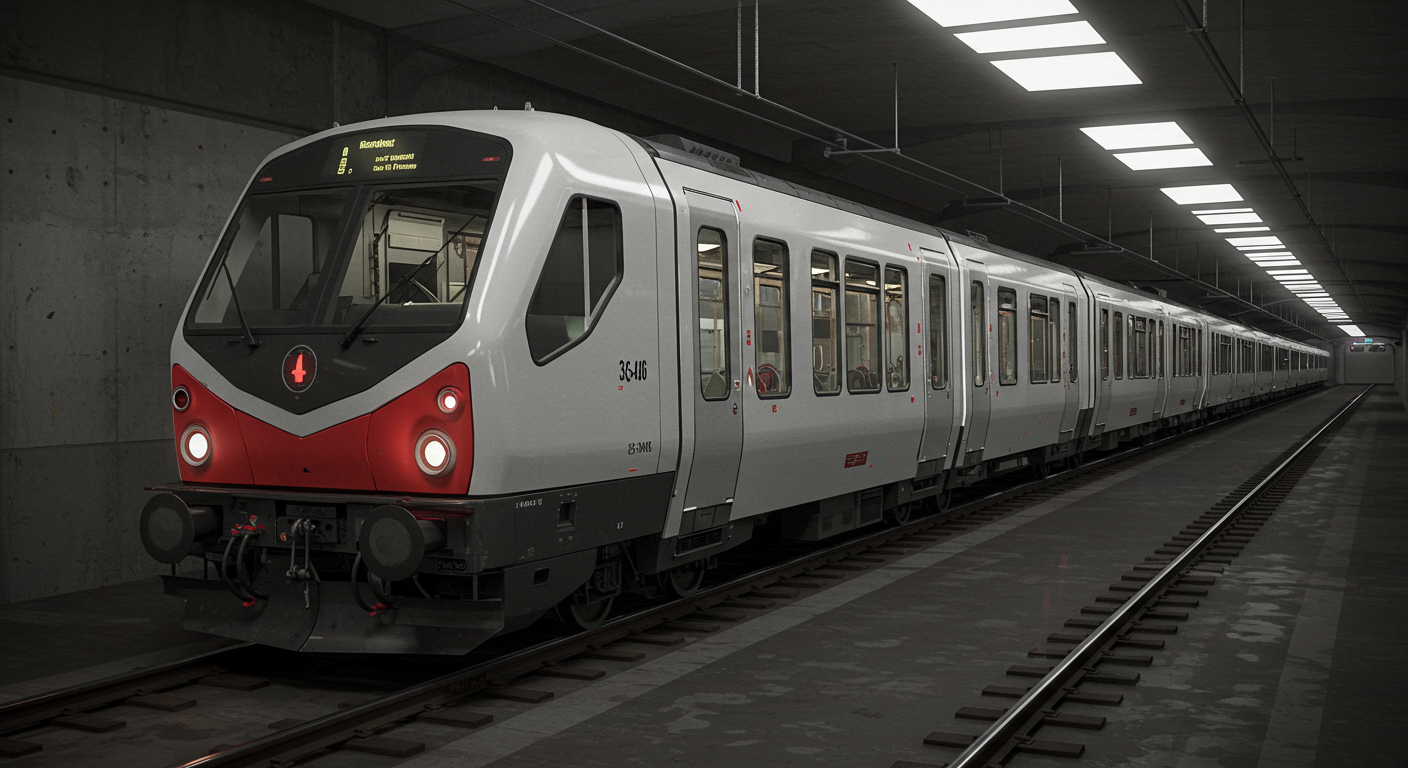Many people rely on trains every day. This could be for commuting to work, traveling across the country, or receiving goods shipped from afar through reliable rail services. Consequently, the smooth operation of these vast and intricate railway networks is something often taken for granted in modern society. However, behind the scenes, a remarkable piece of technology works tirelessly. This ensures everything runs like clockwork, minimizing delays and maximizing coordination. This technology, a powerful system known as the ns mainframe, is the unseen engine making complex railway operations appear simple and reliable to the outside world.
The Critical Role of ns mainframe in Daily Operations
The ns mainframe is particularly crucial for large transportation companies like Norfolk Southern. It is a smart, centralized technology system that operates nonstop to ensure everything runs efficiently.
It diligently manages train schedules, tracks a multitude of vehicles across the network, and, importantly, solves potential problems before they can cause disruptive delays that affect passengers and freight movement.
What if There Were No ns mainframe?
Without such a system, the intricate dance of a modern railway could quickly descend into disarray and inefficiency. Imagine widespread confusion across stations. Think about significantly longer wait times for passengers and freight deliveries. Most critically, picture increased safety risks arising from communication gaps or delayed responses.
The very presence of the ns mainframe helps to prevent these scenarios. This system doesn’t just react to issues; its intelligent design allows it to anticipate and address them proactively—often before anyone notices a problem.
Proactive Problem Solving with ns mainframe Technology
This capability to preempt disruptions is fundamental to its role. Delays in a railway network can have cascading effects, impacting schedules, crew assignments, and customer satisfaction across multiple states and terminals.
The constant, nonstop operational demand on this system explains why a platform known for extreme reliability and continuous availability—like a mainframe—is indispensable.
In an environment where even a minor hiccup can cause major consequences, the robust and dependable nature of mainframe technology provides a necessary foundation of stability. Have you ever marveled at how a vast network of trains, carrying millions of people and tons of goods, operates like a well-oiled machine? A lot of that magic happens thanks to the ns mainframe.
What Exactly is ns mainframe? Let’s Break It Down
So, what is this powerful system really? In simple terms, the ns mainframe is a highly capable, centralized computer system. It is specifically designed to manage and enhance large-scale transportation activities, particularly for Norfolk Southern’s nationwide railway operations.
Think of it as the “brain” behind the entire operation. Just like a human brain coordinates countless bodily functions, the ns mainframe coordinates trains, schedules, safety protocols, and even logistical elements like traffic signals. All of this keeps the entire transport network running smoothly and securely.
More Than Just a Regular Computer: The Power of ns mainframe
It is important to understand that the ns mainframe is not like the personal computers or laptops people use at home or in regular office environments.
Instead, it is a massive, specialized enterprise system. It’s engineered for mission-critical processing and handling colossal data throughput with rock-solid uptime and unmatched reliability.
It is built to process enormous amounts of data in real time, meaning it responds to incoming information as events unfold, not afterward.
Speed and Reliability of the ns mainframe System
This system is incredibly fast and exceptionally reliable. It constantly processes thousands of updates every single second, handling variables like track availability and locomotive locations.
These rapid calculations allow it to make quick, informed decisions that keep people and goods moving efficiently and safely across hundreds of miles of track.
For instance, if one train is running late, the system can immediately recalculate the schedules for other connecting services or adjust platform assignments to minimize disruptions across the network.
Centralized Control with the ns mainframe
The centralized nature of the ns mainframe, where operations are managed from one core system, offers significant advantages. These advantages include centralized control, data consistency, and streamlined decision-making across Norfolk Southern’s geographically vast and complex railway network.
This setup allows for seamless communication and coordination between different departments, yards, and regional teams, ensuring operational cohesion.
Security and Redundancy in the ns mainframe Architecture
However, such centralization also makes the system a critical point of operational leverage. Its continuous and secure functioning is paramount to keeping everything on track.
This central role necessitates substantial investments in security measures and redundancy systems to protect against hardware failures, cyber threats, or data corruption. Any compromise could have far-reaching consequences for national rail service.
Furthermore, the fact that the ns mainframe processes thousands of updates per second indicates that it is far more than just a static database. It is an active, dynamic control system that constantly ingests, processes, and applies real-time data to support immediate operational adjustments.
Safety First: The ns mainframe as a Digital Guardian Angel
Safety is the absolute top priority in all railway operations. The ns mainframe plays a vital role as a digital guardian angel overseeing the network’s well-being.
It is continuously engaged in safety monitoring, which includes tracking signals, identifying hazards on tracks or with equipment, and triggering alerts as necessary to address issues immediately.
This system acts like an ever-vigilant extra set of eyes. For example, if a trackside sensor detects an anomaly or a signal malfunctions, the mainframe flags the issue instantly. Maintenance crews can then investigate and fix it before it becomes a serious problem.
Keeping the Whole Team Connected with ns mainframe
Effective communication is vital for the coordination of any large-scale operation—and railways are no exception. The ns mainframe enables powerful communication and coordination tools that ensure every team member has access to the most current and relevant information.
CrewCall Mainframe: Instant Alerts for ns mainframe Users
One specific feature, the CrewCall Mainframe, allows crew members—like conductors and engineers—to receive instant alerts and messages. These cover schedules, assignments, and any urgent operational updates.
Whether a train engineer is stationed in a major hub or hundreds of miles away, they remain informed and responsive thanks to the centralized communication enabled by the ns mainframe.
Learning and Improving: How ns mainframe Uses Data for a Better Railway
Beyond real-time decision-making, the ns mainframe also excels in data analytics and long-term performance monitoring.
The system collects valuable data on various operational parameters, including train speeds, fuel usage, and delay durations. These insights allow managers to identify inefficiencies and proactively improve services.
For instance, consistent delays at a specific location might indicate an infrastructure bottleneck or a flawed schedule. The mainframe’s analytics help uncover these trends so management can take strategic corrective action.
The Synergy of ns mainframe Capabilities
The diverse capabilities of the ns mainframe—tracking, routing, safety monitoring, communication, and analytics—are not isolated functions. They form an interconnected ecosystem that strengthens overall network performance.
Accurate tracking informs better route planning. Updated routing enhances safety. Real-time analytics feed into strategic decisions. And all of this is held together by robust communication tools.
The result is a synergistic system where the output of one function directly empowers another, delivering superior efficiency and reliability.
ns mainframe: An Evolving Intelligent System
These tightly integrated capabilities signify a major leap forward from traditional, manual operations to a truly intelligent and data-driven transportation system.
This digital transformation is essential for meeting the complex logistical demands of today’s globalized economy.
Who Uses ns mainframe and How? A Peek Behind the Scenes
It may be sophisticated, but its real power is realized through everyday use by Norfolk Southern employees—from dispatchers to engineers.
At the Controls: How Norfolk Southern Employees Use ns mainframe
Accessing the system involves a secure mainframe login process using usernames, passwords, and often one-time passcodes (OTP). This ensures only authorized personnel can access sensitive operational data.
Office staff, such as planners or administrative teams, typically log in through secured web portals or specialized software tools. These often emulate traditional terminal screens for in-depth data review and planning.
ns mainframe on the Move: Access for Crews in the Field
The system is not confined to desks. Through NS Mainframe Mobile, train crews and maintenance staff access schedules and alerts on smartphones and tablets.
The App allows them to check assignments, receive urgent updates, and communicate in real time—all while on the move. This mobile access streamlines field operations, reduces paperwork, and significantly boosts efficiency.
Training for ns mainframe Users
To maximize usability, Norfolk Southern provides specialized training sessions to help both new and experienced employees learn to navigate the system with confidence and speed.
Tailored Access for Diverse ns mainframe Needs
By offering both robust desktop interfaces and streamlined mobile access, it reflects a user-centric design philosophy. Office planners get in-depth analytics, while field personnel receive timely alerts—each tailored to their specific operational roles.
This dual-focus design ensures that the full power of it is accessible across all levels of the organization.
Why ns mainframe is a Game-Changer for Modern Railways
It is not just a technical asset. It is a strategic enabler of Norfolk Southern’s goals, driving safer journeys, more efficient logistics, and smarter operational choices.
Challenges and the Road Ahead: The Future of it
Despite its strengths, maintaining such an advanced system presents challenges.
Cybersecurity remains a constant concern, requiring ongoing investment. Another major issue is the declining pool of mainframe-skilled professionals as many experts retire.
ns mainframe: Innovating for Tomorrow
Looking forward, Norfolk Southern plans to integrate AI to boost automation. The system could soon predict potential issues or dynamically optimize train routes.
Mobile features will be enhanced, and cloud integration is already underway. This allows Norfolk Southern to build hybrid systems that combine mainframe stability with cloud flexibility.
Strategic Importance of ns mainframe Modernization
This approach shows a commitment to modernization without discarding the core advantages of mainframe technology. It strikes a balance between proven reliability and future readiness.
The Human Element in ns mainframe’s Future
Addressing the talent gap will require a multi-faceted approach—recruiting new talent, offering competitive training, and possibly simplifying technical dependencies through innovation.
ns mainframe: More Than Just a Big Computer
In conclusion, it is more than a powerful machine. It is a mission-critical backbone for Norfolk Southern’s railway operations—contributing to speed, safety, and dependability.
ns mainframe: Enabling Strategic Vision
Ultimately, it enables Norfolk Southern to pursue its broader vision: “To be the safest, most customer-focused and successful transportation company in the world.”
Even though it operates largely unseen, its influence is felt in every train that arrives on time, every passenger who gets home safely, and every shipment that reaches its destination efficiently.

